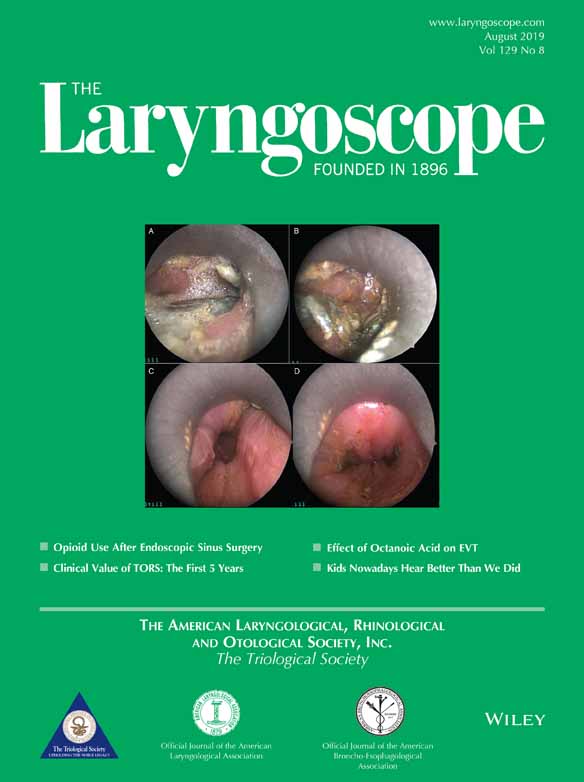Kids Nowadays Hear Better Than We Did: Declining Prevalence of Hearing Loss in US Youth, 1966–2010
Editor's Note: This Manuscript was accepted for publication on May 30, 2018.
Presented at the Annual Meeting of the National Hearing Conservation Association, Orlando, Florida, U.S.A., February 15–17, 2018, and at the Annual Meeting of the American Auditory Society, Scottsdale, Arizona, U.S.A., March 1–3, 2018.
This work was supported by the National Institute on Deafness and Other Communication Disorders (NIDCD), National Institutes of Health (NIH), which provided funding for the hearing component of the National Health and Nutrition Examination Survey 2005–2010 via interagency agreements with the National Center for Health Statistics and the National Institute for Occupational Safety and Health (NIOSH), Centers for Disease Control and Prevention (CDC). c.l.t. was supported in part by interagency agreements between the NIDCD, NIH, and NIOSH, CDC. Other than the authors, the funding organizations (NIDCD and CDC) had no role in the design, analysis, and interpretation of the secondary analysis of data; or in the preparation, review, and approval of the article; and the decision to submit the manuscript for publication.
The findings and conclusions in this article are those of the authors and do not necessarily represent the official position of the governmental agencies or other institutions for which they work. h.j.h., k.g.l., and c.l.t. are US federal employees; they have no conflicts of interest to declare. r.a.d. is a member of the faculties of the University of Texas Health Science Center at San Antonio and the University of California at Davis and has a private consulting practice in otology. g.a.f. has a private consulting practice in audiology.
The authors have no other funding, financial relationships, or conflicts of interest to disclose.
Abstract
Objectives/Hypothesis
To investigate factors associated with hearing impairment (HI) in adolescent youths during the period 1966–2010.
Study Design
Cross-sectional analyses of US sociodemographic, health, and audiometric data spanning 5 decades.
Methods
Subjects were youths aged 12 to 17 years who participated in the National Health Examination Survey (NHES Cycle 3, 1966–1970; n = 6,768) and youths aged 12 to 19 years in the Third National Health and Nutrition Examination Survey (NHANES III, 1988–1994; n = 3,057) and NHANES (2005–2010; n = 4,374). HI prevalence was defined by pure-tone average (PTA) ≥ 20 dB HL for speech frequencies (0.5, 1, 2, and 4 kHz) and high frequencies (3, 4, and 6 kHz). Multivariable logistic models were used to estimate the odds ratio (OR) and 95% confidence interval (CI).
Results
Overall speech-frequency HI prevalence was 10.6% (95% CI: 9.7%-11.6%) in NHES, 3.9% (95% CI: 2.8%-5.5%) in NHANES III, and 4.5% (95% CI: 3.7%–5.4%) in NHANES 2005 to 2010. The corresponding high-frequency HI prevalences were 32.8% (95% CI: 30.8%-34.9%), 7.3% (95% CI: 5.9%-9.0%), and 7.9% (95% CI: 6.8%-9.2%). After adjusting for sociodemographic factors, overall high-frequency HI was increased twofold for males and cigarette smoking. Other significant risk factors in NHANES 2005 to 2010 included very low birth weight, history of ear infections/otitis media, ear tubes, fair/poor general health, and firearms use.
Conclusions
HI declined considerably between 1966 to 1970 and 1988 to 1994, with no additional decline between 1988 to 1994 and 2005 to 2010. Otitis media history was a significant HI risk factor each period, whereas very low birth weight emerged as an important risk factor after survival chances improved. Reductions in smoking, job-related noise, and firearms use may partially explain the reduction in high-frequency HI. Loud music exposure may have increased, but does not account for HI differences.
Level of Evidence
NA
Laryngoscope, 129:1922–1939, 2019




